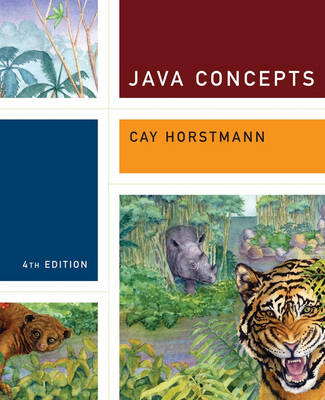
Java Concepts
John Wiley & Sons Inc (Verlag)
978-0-471-69704-6 (ISBN)
- Titel ist leider vergriffen;
keine Neuauflage - Artikel merken
Think like a programmer! Now updated to integrate Java 5.0, Cay Horstmann's Java Concepts, Fourth Edition provides an up--to--date, highly effective, and accessible introduction to the Java language and a solid grounding in fundamental computer science concepts. Drawing on his many years of experience as a career programmer and teacher, Horstmann will inspire you to think like a programmer and develop the problem--solving skills you need to succeed in your course and future career. Features Updated coverage to integrate Java 5.0. The text can still be used with older versions of Java. An approach that goes beyond language syntax to focus on computer science concepts and problem solving. The text encourages you to think as a problem solver and equips you with the tools you need to design efficient and successful programs. Review of Chapters 2 and 3 shows a gradual and student--friendly approach that is a Horstmann trademark. Horstmann provides extras like Quality Tips and Productivity Hints that give the user an inside track on the material. As always, there is a strong emphasis on the pragmatic and practical aspects of programming.
Carefully developed problems and easy--to--understand examples. Java Concepts is loaded with exercises and examples, and you can find the code for examples online. The Programming Style Guide. Available online, the Programming Style Guide helps you develop a consistent style for all of your programming projects. New to this edition is an accessible and colorful text layout that helps you find the information that you need when you need it. Other books by Cay Horstmann Big Java, Second Edition, 0--471--70615--9 Object--Oriented Design and Patterns, 0--471--31966--X Big C++ (with Timothy Budd), 0--471--47063--5 Computing Concepts with C++ Essentials, Third Edition, 0--471--16437--2
Preface.Special Features.Chapter 1. Introduction.1.1 What is programming.1.2 The Anatomy of a Computer.1.3 Translating Human Readable Programs to Machine Codes.1.4 The Java Programming Language.1.5 Becoming Familiar with Your Computer.1.6 Compiling a Simple Program.1.7 Errors.1.8 The Compilation Project.Chapter 2. Using Objects.2.1 Types and Variables.2.2 The Assignment Operator.' 2.3 Objects, Classes and Methods.2.4 Methods, Parameters and Return Values.2.5 Number Types.2.6. Constructing Objects.2.7 Accessor and Mutator Methods.2.8 Implementing a Test Program.2.9 The API Documentation.2.10 Object References.Chapter 3. Implementing Classes.3.1 Black Boxes.3.2 Design and Public Interface of a Class.3.3 Commenting the Public Interface.3.4 Instance Fields.3.5 Implementing Constructors and Methods.3.6 Testing a Class.3.7 Categories of Variables.3.8 Implicit and Explicit Method Parameters.Chapter 4. Fundamental Data Types.4.1 Number Types.4.2 Constants.4.3 Assignment, Increment, and Decrement.4.4 Arithmetic Operations and Mathematical Functions.4.5 Calling Static Methods.4.6 Strings.4.7 Reading Input.Chapter 5. Programming Graphics (Optional).5.1 Frame Windows.5.2 Drawing Shapes.5.3 Graphical Shapes.5.4 Colors.5.5 Drawing Complex Shapes.5.6 Reading the Text Input.5.7 Comparing Visual and Numerical Information.Chapter 6. Decisions.6.1 The if Statement.6.2 Comparing Values.6.3 Multiple Alternatives.6. 4 Using Boolean Expressions.Chapter 7. Iteration.7.1 while Loops.7.2 for loops7.3 Nested Loops7.4 Processing Sentinel Values.7.5 Random Numbers and Stimulations.Chapter 8. Arrays and Array Lists.8.1 Arrays.8.2 Arrays Lists.8.3 Wrappers and Auto-Boxing.8.4 The Generalized for Loop.8.5 Simple Array Algorithms.8.6 Two-Dimensional Arrays.8.7 Copying Arrays.Chapter 9. Designing Classes.9.1 Choosing Classes.9.2 Cohesion and Coupling.9.3 Accessors, Mutators, and Immutable Classes.9.4 Side Effects.9.5 Preconditions and Postconditions.9.6 Static Methods.9.7 Static Fields.9.8 Scope.9.9 Packages.Chapter 10. Testing and Debugging.10.1 Unit Tests.10.2 Providing Test Input.10.3 Test Case Evaluation.10.4 Regression Testing and Test Coverage.10.5 Logging.10.6 Using a Debugger.10.7 A Sample Debugging Session.Chapter 11. Interfaces and Polymorphism.11.1 Using Interfaces of Code Reuse.11.2 Converting Between Class and Interface Types.11.3 Polymorphism.11.4 Using Interfaces for Callbacks.11.5 Inner Classes.11.6 Processing Timer Events.11.7 Accessing Surrounding Variables.Chapter 12. Event Handling (Optional).12.1 Events, Event Sources and Event Listeners.12.2 Building Applications with Buttons.12.3 Processing Text Input.12.4 Mouse Events.Chapter 13. Inheritance.13.1 An Introduction to Inheritance.13.2 Inheritance Hierarchies.13.3 Inheritance Instance Fields and Methods.13.4 Subclass Construction.13.5 Converting between Subclass and Superclass Types.13.6 Polymorphism.13.7 Access Control.13.8 Object: The Cosmic Superclass.Chapter 14. Graphical User Interfaces.14.1 Using Inheritance to Customize Frames.14.2 Layout Management.14.3 Choices.14.4 Menus.14.5 Text Areas.14.6 Exploring the Swing Documentation.Chapter 15 Exception Handling.15.1 Throwing Exceptions.15.2 Checked and Unchecked Exceptions.15.3 Catching Exceptions.15.4 The finally Clause.15.5 Designing Your Own Exception Types.15.6 Case Study: A Complete Example.Chapter 16. Files and Streams.16.1 Reading and Writing Text Files.16.2 Text and Binary Formats.16.3 An Encryption Program.16.4 Random Access.16.5 Object Streams.Chapter 17. Object Oriented Design.17.1 The Software Life Cycle.17.2 Discovering Classes.17.3 Relationship Between Classes.17.4 Case Study: Printing an Invoice.17.5 Case Study: An Automatic Teller Machine.Chapter 18. Recursion.18.1 Triangle Numbers.18.2 Permutations.18.3 Recursive Helper Methods.18.4 Mutual Recursions.18.5 The Efficiency of Recursion.Chapter 19. Sorting and Searching.19.1 Selection Sort.19.2 Profiling the Selection Sort Algorithm.19.3 Analyzing the Performance of the Selection Sort Algorithm.19.4 Merge Sort.19.5 Analyzing and Merge Sort Algorithm.19.6 Searching.19.7 Binary Search.19.8 Sorting Real Data.Chapter 20. An Introduction to Data Structures.20.1 Using Linked Lists.20.2 Implementing Linked Lists.20.3 Abstract and Concrete Data Types.20.4 Stacks and Queues.Chapter 21. Advanced Data Structures.21.1 Sets.21.2 Maps.21.3 Hash Tables.21.4 Computing Hash Codes.21.5 Binary Search Trees.21.6 Tree Traversal.21.7 Using Tree Sets and Tree Maps.21.8 Priority Queues.21.9 Heaps.21.10 The Heapsort Algorithm.Chapter 22. Generic Programming.22.1 Type Variables.22.2 Implementing Generic Classes.22.3 Generic Methods.22.4 Constraining Type Variables.22.5 Raw Types.Appendix A: Java Language Coding Guidelines.Appendix B: The Basic Latin and Latin-1 Subsets of Unicode.Appendix C: The Java Library.Appendix D: Adapting Java 5 Programs to Older Compilers.Appendix E: Java Syntax Summary.Appendix F: Java Operator Summary.Appendix G: Java Keyword Summary.Appendix H: Metric Conversion Factors.Appendix I: HTML Summary.Appendix J: Tool Summary.Appendix K: Javadoc Summary.Appendix L: Number Systems.Appendix M: Bit and Shift Operations.Appendix N: UML Summary.Glossary.Index.Illustration Credits.
| Erscheint lt. Verlag | 2.9.2005 |
|---|---|
| Zusatzinfo | Illustrations (some col.) |
| Verlagsort | New York |
| Sprache | englisch |
| Maße | 190 x 238 mm |
| Gewicht | 1467 g |
| Einbandart | Paperback |
| Themenwelt | Informatik ► Programmiersprachen / -werkzeuge ► Java |
| Mathematik / Informatik ► Informatik ► Web / Internet | |
| ISBN-10 | 0-471-69704-4 / 0471697044 |
| ISBN-13 | 978-0-471-69704-6 / 9780471697046 |
| Zustand | Neuware |
| Informationen gemäß Produktsicherheitsverordnung (GPSR) | |
| Haben Sie eine Frage zum Produkt? |
aus dem Bereich


